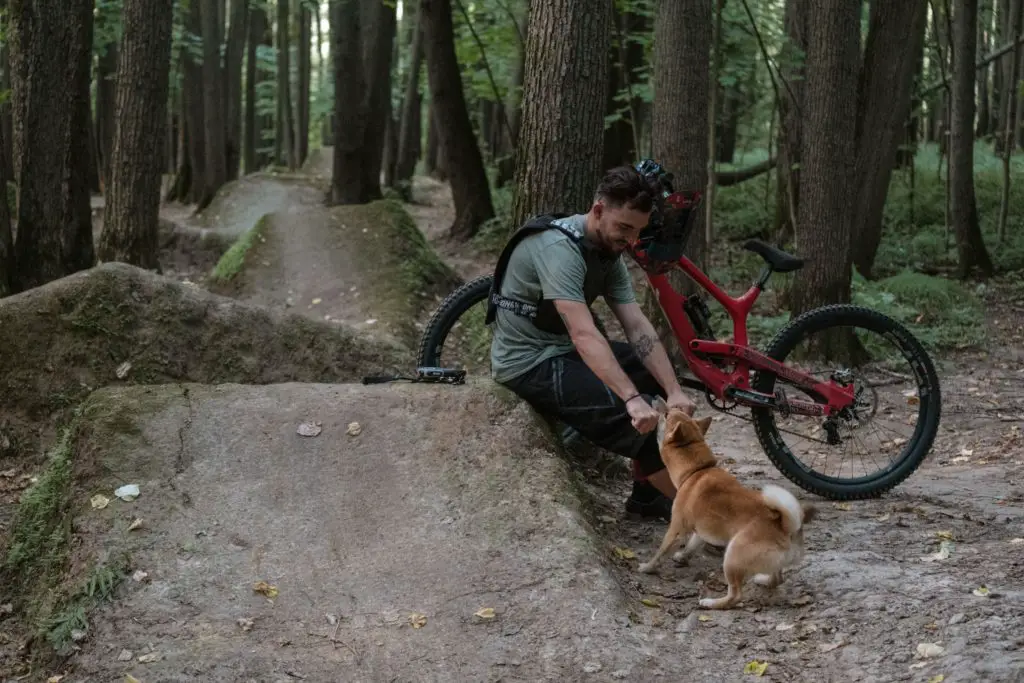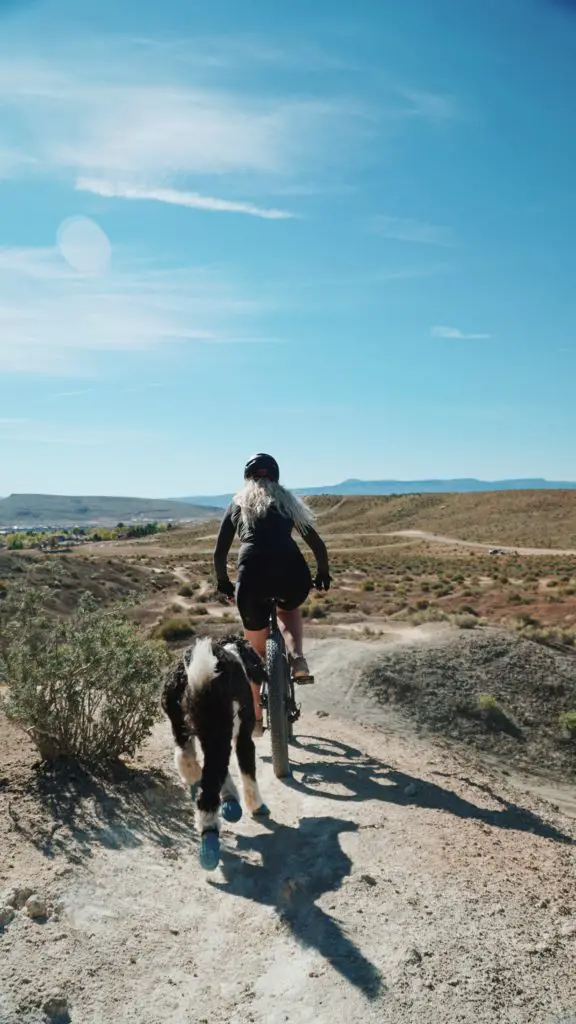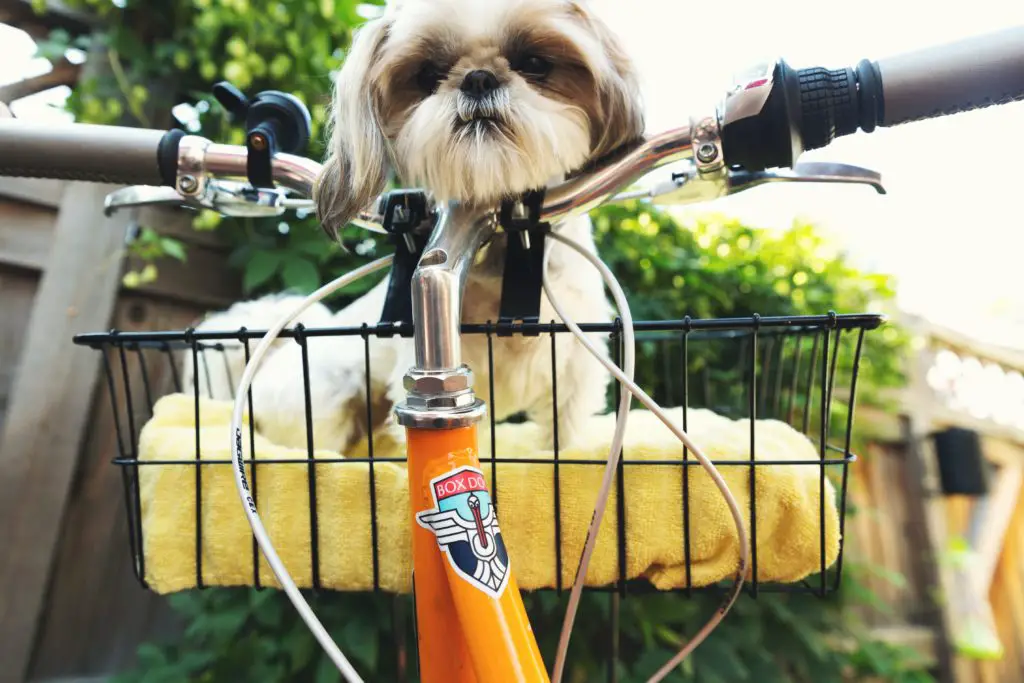Dog owners often think of walking or running with their dogs. Those that like to go for a bike ride want to know how to train a dog to run next to a bicycle.
The two most common ways you see canines accompanying their owners on a bicycle ride is riding as a passenger or running alongside the bike.
Most cities, bike paths, and parks require a dog to be on a minimum of a six feet leash. The safest way to bike with your dog is by committing time to teach your dog. The same goes for dogs that will ride along as a passenger. Dogs that ride as passengers often do so in bike trailers.
Related Articles:
- How to Stop Your Dog from Peeing When Excited
- How to Train Your Dog with Positive Reinforcement
- How to Train Your Dog to Walk on a Leash
- How to Train Your Dog to be Social
In How to Train a Dog to Run Next to a Bicycle, we will look at the criteria for good runners, dogs that are natural runners, physical health concerns, manners required for dogs that like to run with their owners, suggested equipment, and simple steps to train a dog to run next to a bicycle.

How to Train a Dog to Run Next to a Bicycle: Criteria for Good Runners
Before you begin to train a dog to run next to a bicycle consider the following criteria.
- Do they like to run?
- Any physical limitations that would be detrimental to the dog’s health?
- Does your dog walk nicely on leash?
- Is your dog trained well to respond to you?
- Has your dog been socialized?
- Can your dog obey in the midst of distractions?
The above list is attainable with time and patience. A well-socialized and trained dog can go more places and join their humans in many adventures.
Related Articles:
- Basic Dog Training Commands
- How to Get a Dog to Take a Pill
- How to Crate Train a Dog
- How to Measure a Dog for a Harness
How to Train a Dog to Run Next to a Bicycle: Natural Runners
First, you need to determine if your dog enjoys running. Not every dog is built for running next to a bicycle. Before you train a dog to run next to a bicycle, first ask yourself if they would enjoy that activity.
Dogs that are natural running athletes, love physical activity, and enjoy being outdoors are good choices. Often dog breeds that are in the category of hunting and herding make good runners. These types of dogs are bred to endure long distances and like a “job” to do.
Biking with your dog allows your dog to be outdoors and exercise right alongside you. Just as you physically prepare for a bike ride, you will want to prepare your dog as well. They will need to condition and work up to duration with you.
Typically, dog breeds that are naturally active are Australian Shepherds, Border collies, Cattle dogs, Vizslas, and Weimaraners. They are naturally high-energy and like to run. Other breeds that may enjoy running (in cooler weather) are the Labrador Retriever and Siberian Husky.
A dog that would be better as a passenger would include dogs with short muzzles such as the pug, French bulldogs, bulldogs, and Boston terriers.
Related Articles:
- Ultimate Guide: How To Take Care Of A Puppy
- Ultimate Guide: How To Take Care Of A Dog
- Ultimate Guide: How To Take Care Of A Senior Dog
- The Benefits of Owning a Dog
- Top 12 Tips for First Time Dog Owners
- How to Train a Dog

How to Train a Dog to Run Next to a Bicycle: Health Concerns
The next consideration is your dog’s health. While you are biking and can take a break easily, your dog will be running the entire time.
At your dog’s annual check-up ask your vet about beginning a new exercise activity. A few health concerns would be the weight of your dog, dogs that have inflammation due to arthritis, or dogs that have been diagnosed with hip dysplasia.
Ask your veterinarian about giving your dog a joint supplement at an early age. Prevention is key for dogs that want to live an active life.
At what age is best to begin? It is best to wait to run your dog until their growth plates are completely developed. Ask your veterinarian if you have any questions about what age to begin biking with your dog.
Related Articles:
- How to Train a Deaf Dog to Stop Barking
- How to Get the Attention of a Deaf Dog
- How to Train a Deaf Dog to Sit and Stay
- How to Train a Deaf Dog with Hand Signals
- How to Train a Deaf Dog
- How to Potty Train a Deaf Dog
While you wait until your dog has completed growing, you can use that time wisely and work on walking nicely on a leash. Depending on the breed, you could wait until your dog reaches 12 months up to 24 months old. Using those years to teach your dog solid leash manners will prove valuable for when your dog is ready to run next to a bicycle.
If your dog begins to limp, pant heavily, drool excessively or significantly slow down then it is time to stop. Your dog will need adequate recovery time so they can safely enjoy being active.
How to Train a Dog to Run Next to a Bicycle: Walking Nicely & Manners
The very first step before taking a bike ride with your dog is to teach them to walk nicely on a leash. Enroll in a local dog training class or watch informative videos on how to train your dog.
Spend time training your dog so they are walking with a loose leash. Every dog owner desires a dog that does not pull while they are trying to ride a bicycle. A dog that is obedient and paying attention to their owner is ready for more adventure opportunities such as running next to a bicycle.
Heel. Your dog needs to know where heel position is located. They also need to know how to stay in this position when necessary.
Come. Another phrase for this command is recall. Practice at home and practice with all kinds of distracting. Your dog needs to be 100% as possible with coming when called.
Down. Down position is very important to dogs and dog owners. When you have stopped moving, and you want your dog to rest, place them in the down position.
Leave It. Once you leave the safety of your home, your dog will encounter all kinds of interesting smells and objects. Use the leave it command to help your dog mind their business and not eat something that could harm them.
Follow Me. This command allows you to communicate with your dog more effectively. When safety dictates that your dog runs behind and not beside you this command is essential.
Dogs are intelligent animals and will thrive on learning the obedience commands that will make running next to a bicycle a rewarding experience for all.
Related Articles:
- Can Dogs Eat Shrimp?
- Can Dogs Eat Almonds?
- How to Cook Marrow Bones for Dogs
- How to Cook Liver for Dogs
- How to Get a Picky Dog to Eat
- How to Get Your Dog to Eat
How to Train a Dog to Run Next to a Bicycle: Suggested Equipment
The two most important pieces of equipment for your dog is a harness and leash. Here are suggestions on other items to use while biking with your dog.
- Harness. The best harness for your dog is the one that is most comfortable for them. The harness should fit so that the dog cannot back out but loose enough for ease of movement.
- Leash. Many people that run with their dogs like the hands-free leashes. Choose one that fits your situation and is comfortable for you.
- Paw Protection. Protect your dog’s paw by using a wax-based product that is designed to be used on a dog’s paws.
- Pet ID Tags. Collar tags should include your dog’s name and your contact information.
- Poop Bags. Always have a few on hand. Poop containers are convenient until a trash receptacle can be found.
- Collapsible Water Dish. A lightweight silicone water dish is essential for much needed water breaks.
- Canine First Aid Kit. When you bike long-distance or bike in remote areas, carry a first aid kit for injuries like torn paw pads.
Enjoy learning how to teach a dog to run next to a bicycle with using the right equipment. Once you have a comfortable harness and leash you are ready to get started!
How to Train a Dog to Run Next to a Bicycle: 4 Simple Steps
It depends on the dog whether or not they will be frightened of a moving bicycle. Start with these five simple steps.
- Introduce your dog to the bicycle. Let them sniff the bike. If your dog appears scared, take this step slowly. As your dog moves towards the bike, treat them and retreat. Keep repeating until they can confidently walk up to sniff around the bike.
- Moving the bike. The next step is gently introducing a moving bike. Begin walking slowly with your bike and your dog. Praise and treat your dog for being calm. You want your dog to focus on you and not worry about the bike. Keep practicing this step until your dog can walk calmly beside you walking your bike.
- Riding the bike. Start to ride your bike slowly while holding your dog’s leash. Praise your dog. Go slowly around your house to allow your dog to get used to the moving bike.
- Add distance to your bike ride. Start with a five-to-ten-minute bike ride with your dog. Know your dog – watch for signs of fatigue or injury. Continue to add time and distance as your dog adjusts to running beside your dog.

How to Train a Dog to Run Next to a Bicycle
If you decided that your dog is a good match for learning to run next to a bike follow the same Rules for Walking Your Dog. Stay on the trails and clean up after your dog.
Remember to offer your dog water during your bike ride as well. Spending quality time doing what you and your dog love is rewarding.
Relevant Articles:
- How to Train a Dog
- The Top 5 Basic Dog Training Commands
- How to Obedience Train Your Dog
- How to Leash Train Your Dog
- How to Train Your Dog to Walk on a Leash
- Rules of How to Walk Your Dog
Please read our Legal Disclaimer

